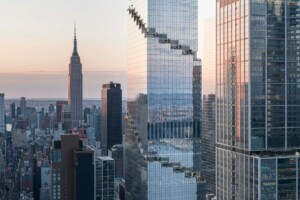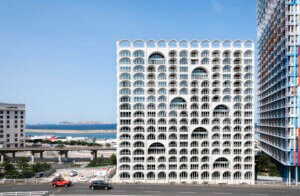The Architect’s Newspaper’s Facades+ conference kicked off today in New York and wasted no time getting into the action. French architect Dominique Perrault opened the conference with a keynote discussing a number of buildings from around the world (three of which are featured here), each utilizing facade systems in different ways, ranging from below-grade skins to “tree-like” designs.
An overarching theme of the projects Perrault presented was the use of the facade as a democratizing tool that filtered between the public and private realms, defining spaces both inside and out. An example of this could be seen with the refurbishment of Pont de Sèvres Towers (now know as “CityLights”), a collection of three office high-rises in Boulogne-Billancourt, France.
Here, “the facade follows you into the building,” said Perrault, explaining how the predominantly glass-based facade acts as a device that dampens the street/structure threshold. The concept of the threshold, however, prevails. More formal spaces branch out from a triple-height entranceway, likened by Perrault to a “theater” that looks out onto a large plaza in front of the two towers it is nestled between.
For the upper reaches of the towers, Perrault prescribed more glass fenestration, the lighting arrangement of which gives the complex its new name. The interiors, meanwhile, were reorganized so that “everybody has a window,” thus providing much access to daylight. Come sundown, spotlights illuminate the angled nature of the skin, highlighting its textural qualities. Perrault described the structures’ presence on the landscape as “magic mountain.”
“Access” was another key element of his speech. Perrault demonstrated how facades contribute to this in a multifaceted way. This could be seen at the Ewha Womans University in Seoul, South Korea, where the building is built into the site, divided by a wide, sloping walkway that splits the project’s two volumes, seemingly carving its way through the landscape.
When designing below grade, Perrault noted that making the most of light is important. The wide path allows light to penetrate fenestration on both sides path. At night, the light emitted from these facades illuminates the outdoor area. Both of these qualities would usually suggest a very open and transparent facade. However, the vertical arrangement of window panels and angular approach to the building obscure views inside.
This is necessary, as the walkway is a public street that extends from the local subway station. The area, however, has become a place for student congregation and activity, most notably being a venue for political protests (one of which attracted 3,000 students) against the incumbent South Korean president. “The design of this was initially a geographical statement and now it is a political story,” Perrault noted.
Keeping with East Asia, Perrault pointed to another project in Asia the Fukoku Life Tower in Osaka, Japan, which features a tapering facade that splays out at the base. This was in response to insurance firm Fukoku’s desire to share the base of the of the tower with the public, creating what Perrault called “an atrium for the people,” likening the form to that of a tree. “We changed the morphology of the basement, twisting the ‘trunk of the tree’ and connecting with the urban fabric which resulted in a very pure geometry,” Perrault said. “The world is not flat, and never is the facade!”
Another building discussed by Perrault was the Mechanics Hall at École polytechnique fédérale de Lausanne (EPFL), in Switzerland. An in-depth article on the building and its facade was featured by John Stoughton of The Architect’s Newspaper and can be found here.










